Search Results
BART’s groundbreaking Not One More Girl initiative launching Phase II with focus on community care and new resources for riders
On Friday, June 2, BART and community-based organizational lead partner the Betti Ono Foundation and The Unity Council’s Latina Mentoring & Achievement Program will launch a series of pop-up events for Not One More Girl, a community-driven initiative to address sexual harassment on transit. The launch comes
Local beekeeper makes honey with bees removed from BART property, protecting riders and helping to preserve the critical insect
If you passed by the four-inch notch in the wall on Bailey Road next to BART’s Pittsburg/Bay Point Station, you probably wouldn’t notice a thing. But if you took a closer look – not too close – you’d find a hive of hundreds of buzzing honeybees. The notch in the wall seemed like a keyhole into another world –
BART Board approves project team to build-out new headquarters with priority of small and minority-owned business involvement
The BART Board of Directors, at its June 25th meeting, voted to award a $58 million Progressive Design-Build contract to Turner Construction Company and RIM Architecture to design and build the new BART Headquarters at 2150 Webster Street in Oakland. BART purchased the modest size building on December 10
BART PD makes arrests in fatal shooting in plaza above 24th Street/Mission Station in San Francisco
Updated 4pm, December 28: The BART Police Department working in conjunction with the San Francisco Police Department has arrested two suspects wanted in connection with the December 18th fatal shooting in the street-level plaza above the 24th Street/Mission BART Station in San Francisco. A 19-year-old man and
No BART service between Lafayette & Pleasant Hill Wed. noon-3:30pm, bus bridge set up
In cooperation with the ongoing NTSB investigation, on Wednesday, October 23, 2013 from noon to 3:30 pm, BART will need to operate a bus bridge between Lafayette Station and Pleasant Hill/Contra Costa Centre Station. This means there will be no BART train service between Lafayette, Walnut Creek and Pleasant
BART partners with the San Francisco Asian Women’s Shelter and artist Amanda Phingbodhipakkiya to confront domestic violence on public transit
Let's Talk About Us posters on digital screens at Powell Station The San Francisco Asian Women’s Shelter (AWS) and artist Amanda Phingbodhipakkiya are partnering with BART to launch a new domestic violence prevention campaign, “Let’s Talk About Us,” to reach Bay Area residents and BART riders. The public art
Melissa Hernandez
One more week to submit a poem to the BART Lines Teen Poetry Contest (deadline: March 8)

Submissions are open - Click HERE to Submit
Official contest page: bart.gov/bartlines
Deadline to Submit: Friday, March 8, 2024, at 11:59pm PST (or sooner - see below)
IMPORTANT: Only 300 qualifying submissions will be accepted for review. The submission period will close when 300 applications are received, which may be before the stated deadline. We indicate on this page when we have received approximately 225 applications. We will close the Submittable application page when 300 qualifying submissions have been received.
Applicants must be between the ages of 13 to 19 as of Friday, March 8, 2024.
Interested in promoting the BART Lines Teen Poetry Contest at your school, library, or organization? Download this printable flyer (PDF).
Friday, Jan. 19 - We are pleased to announce the 2024 BART Lines Teen Poetry Contest. This will be BART’s first writing contest for youth, following last year’s short story contest for adults.
With the BART Lines Teen Poetry Contest, BART is thrilled to lift and amplify the voices of Bay Area youth, whose perspectives, opinions, and ideas are providing us with a roadmap for the future – one that is informed by their lived experiences as well as the unique histories of their communities. We are listening and learning from you!
By providing a forum for teens’ voices and creativity with BART Lines, we are underlining our belief that the words, ideas, and foresight of youth matter. One day soon, they will be the leaders and visionaries that decide the future of public transportation, and therefore, the future of our region.
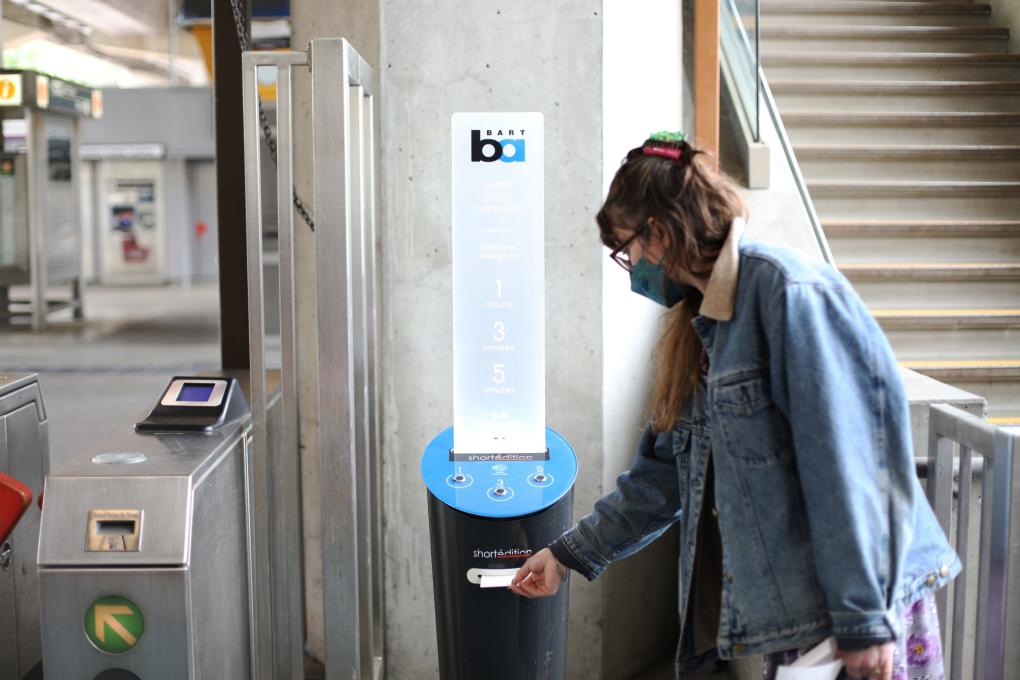
Pictured above: One of BART’s free story dispensers, where the winning poems will be uploaded. The dispensers are like vending machines for creative writing, dispensing stories on eco-friendly recyclable, receipt-like paper. They’re touchless; you just hover your finger over the button to get your story.
BART Lines was created by BART Communications and BART’s Art Program. BART is organizing programs such as BART Lines to get people excited about transit and to emphasize the variety of ways you can use our system, as well as the places it can take you. By partnering with local organizations, including BART Lines partners and judges 826 Valencia and Youth Speaks, we are reinforcing the value arts and cultural organizations bring to BART and our community of riders. These partnerships also highlight the key role public transportation plays in connecting people to experiences that have the power to change and enrich their lives.
BART’s new ridership model emphasizes weeknight and weekend travel, which reinforces the notion that we are not simply a commuter service that transports people to and from work. Our system also carries people to impactful encounters and locations, be it museums, theaters, libraries, public parks, and people, too.
The BART Lines Teen Poetry Contest is one piece of BART’s robust rider engagement strategy that seeks to bring riders together through unique experiences in both virtual and IRL formats. Recent efforts include the BART Anime Project , the One Book One BART book club, Twitch livestreams, creative and informative TikTok content, shareable rider guides, and free celebratory events in stations and trains.
When we ride transit, we hold space for one another. On a crowded train, we remove our backpacks and latch our bikes; we stand for someone who needs to sit; and we scooch to the window seat when space is sparse. Riding transit reminds us that we exist in an interconnected web of others – your fellow passengers, who carry with them their dreams, imaginings, and aspirations (along with their shopping bags and suitcases). BART Lines seeks to celebrates this.
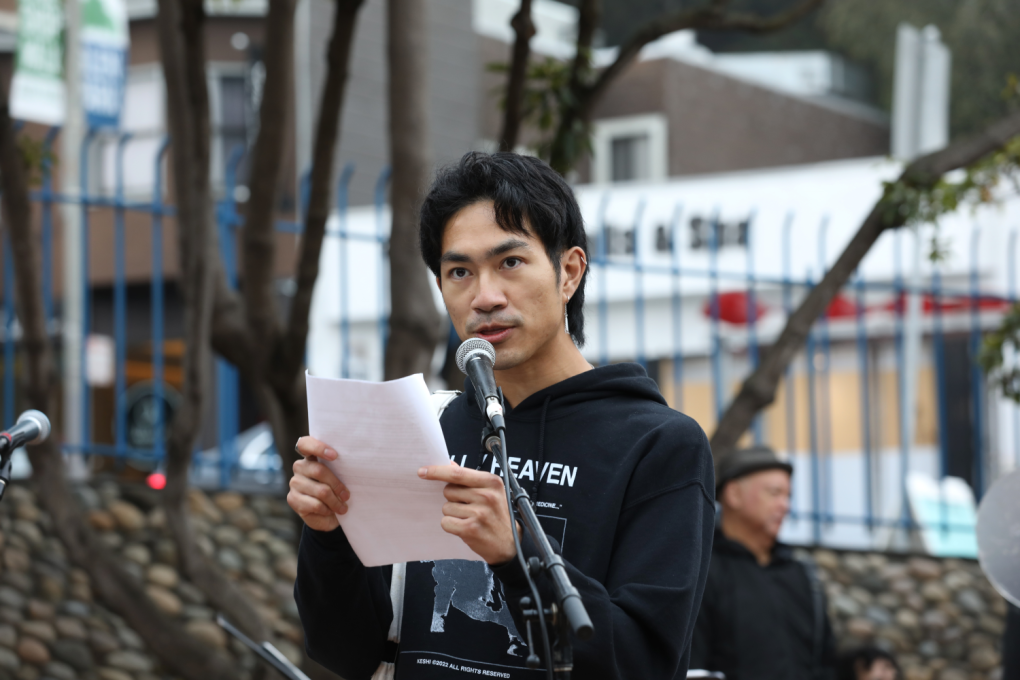
Pictured above: A BART Lines winner reads his poem at Glen Park Station.
Theme: Bay is Home
The theme for the BART Lines Teen Poetry Contest is “Bay is Home.” We want to read your poems related to the Bay Area. Your submission might describe a location – somewhere you take BART, for example – or maybe a specific spot that inspired your piece. With this theme, we’re asking: How do the many places, people, and aspects of the region make the Bay home?
Submissions-Timeline-Prizes
To submit an entry, authors must be between the ages of 13 to 19 as of Friday, March 8, 2024, and reside in one of the five counties where BART operates: San Francisco, San Mateo, Alameda, Contra Costa, and Santa Clara.
Submissions must not exceed 7,500 characters (including spaces). Each line longer than will fit on the dispenser print-outs, typically about 38-40 characters and spaces, will be divided as needed with a slash ("/"). Finalists may be required to edit their work to fit the dispenser format. BART will coordinate with you to finalize your work for publication.
To learn more, see the contest rules and submit your poem, click here. Authors may submit only one poem, including if they are co-author.
Thirty finalists will be selected by BART Lines partners 826 Valencia and Youth Speaks, two standout Bay Area organizations lifting the voices of teen poets. Each finalist will receive a $75 honorarium and their poem will be published in BART’s Short Édition Story Dispensers and Story Discs (scroll down for locations), as well as the BART Short Edition website. Select finalists will be invited to participate in a series of readings in and around BART stations (not a requirement for submitting a poem for consideration).
Judges/Partners
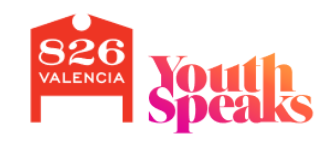
826 Valencia is a nonprofit organization dedicated to supporting under-resourced students ages six to eighteen with their creative and expository writing skills and to helping teachers inspire their students to write. Our services are structured around the understanding that great leaps in learning can happen with individualized attention and that strong writing skills are fundamental to future success.
Youth Speaks is a leading presenter of Spoken Word performance, education, and youth development programs that was founded in San Francisco in 1996. Founded in 1996 in San Francisco, Youth Speaks is a leading presenter of Spoken Word performance, education, and youth development programs. Trailblazers of local and national youth poetry slams, festivals, and more, Youth Speaks offers a comprehensive slate of literary arts education programs and provides numerous opportunities for youth to be published and heard.
About BART’s Short Édition Story Dispensers and Story Discs
Short Édition is a French publishing house of short literature: poetry, short stories, and flash fiction. In addition to its online platform, Short Édition publishes fiction around the world via its Short Story Dispensers and Story Discs (a digital version of the dispensers that allow you to access unlimited content for free on a smartphone) for the public to enjoy a serendipitous literary experience, free of charge.
The dispensers are like vending machines for creative writing, dispensing stories on eco-friendly recyclable, receipt-like paper. They’re touchless; you just hover your finger over the button to get your story.
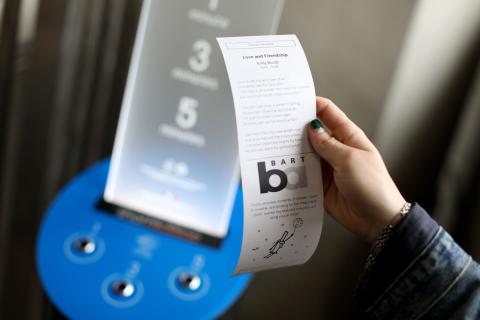
BART’s Story Dispensers are currently located at the following stations:
- Balboa Park
- Downtown Berkeley
- Fruitvale
- Pleasant Hill
- San Leandro (pending installation)
BART will soon install Story Discs at the following stations:
- Daly City
- Dublin/Pleasanton
- Embarcadero
About the Artist Behind the Contest Art
Amy Wibowo is a public transit fan and a creative technologist whose art ranges from sweaters made on a hacked knitting machine to RFID jewelry. Her work has been featured in The New Yorker, Forbes, and Vox. She is also the author and illustrator of Bubblesort Zines, a zine series making computer science topics more accessible to a wider audience. Wibowo was chosen from a pool of artists selected from an open call for California-based artists for BART’s Anime Project.
Quotes from Contest Organizers and Partners
Alicia Trost, Chief Communications Officer at BART:
“BART Lines is another way for us to connect with current riders while also attracting new riders. Our adult short story contest helped increase ridership as people came to BART seeking out the story dispensers to read local content. It was thrilling to see people post about their experience on social media, noting they rode just to get a story. I’ll never forget the time our General Manager asked a crowd what their favorite thing about BART was, and someone shouted out: ‘The short story dispensers!’ We have no doubt the teen poetry contest will produce the same results.”
Jennifer Easton, BART Art Program Manager:
“The BART Art Program strives to bring the voices of artists into transit spaces in fresh and compelling ways to reflect our communities, to be in dialogue with our riders, to intrigue and compel. By engaging visual artists, writers, musicians and others in our transit spaces they become dynamic, humane, and more Bay Area. Youth poetry in the Bay is so strong right now, and we’re thrilled to bring a small bit of it to the story dispensers.”
Michelle Robertson, BART Storyteller:
“What do BART and poetry have in common? On BART, not only are we given space to read, write, doze, and dream, but we’re also given the gift of sharing space with other people and the stories they hold in their bodies and minds. BART is the ‘great connector of the Bay Area,’ and with BART Lines, we’re gratified to highlight the sometimes-unexpected connections our system enables, not solely in physical space, but also in transcendental space, where poetry lives and breathes.”
Bita Nazarian, 826 Valencia Executive Director:
"826 Valencia is thrilled to partner with BART to bring youth voices to transit stations across the Bay Area. Seeing one's writing in print can have a transformative impact on a young person's life, and we are excited to be a part of such a unique publishing project."
Michelle Mush Lee, Youth Speaks Executive Director:
“Youth Speaks is thrilled to partner with BART on this unique public art project celebrating youth voice and poetry. I see poetry as a universal journey, much like public transportation. Just as BART transports passengers across city lines and social jurisdictions, poetry transcends political and cultural barriers. In each line and verse, lies an invitation to journey beyond our immediate surroundings, to explore landscapes of emotion and thought. It is our vision at Youth Speaks to harness this power, creating a world where words are not just a means of expression, but a vehicle for transformative change, carrying Bay Area residents closer to ourselves and each other.”
BART and the Alliance for Girls release a first-of-its-kind youth-informed framework to improve safety
New report outlines a pathway for BART to increase ridership by centering youth safety
BART, in coordination with the Alliance for Girls, is doubling down on its commitment to empower girls and gender-expansive youth to play a role in helping BART enhance safety, increase ridership, and prevent and address sexual harassment and gender-based violence. A newly released report centers the ideas of local girls and gender-expansive youth by outlining steps BART can take to advance gender equity, create a welcoming environment, and measure the effectiveness of strategies.
Alliance for Girls prepared BART’s first-ever “Youth-Informed Radical Vision of Safety Evaluation Framework” report to document research and outreach conducted for BART in early 2024. Nearly 100 participants, primarily girls and gender-expansive youth who identify as people of color, provided ideas for preventative and interventional safety on BART, focusing on themes of physical and environmental safety, emotional and mental safety, and the safety of others.
The report, along with new data about harassment, were presented to the BART Board of Directors at its December 5th board meeting (watch the presentation in the video above) The BART Board thanked the Alliance for Girls for their partnership and helping BART set a pathway forward with this work. Several members of the public spoke in support of the recommendations laid out in the report.
“Safety, as defined by girls and gender-expansive youth of color, goes beyond the absence of violence," said Chantal Hildebrand, Co-Executive Director of Alliance for Girls. "It encompasses a sense of belonging, respect, representation, and sovereignty. To create truly safe public transit, these values must guide the conversation. We are excited to collaborate with BART to amplify and center their voices as we reimagine public transportation.”
Ideas from girls and gender-expansive youth to reimagine safety
During three Community Learning Exchanges and one Meaning Making Session, youth shared their experiences riding BART, and using visualization exercises, offered specific ideas regarding what they need to feel safe on transit. The report documents these ideas and encourages BART to explore the implementation of each one.
The participants outlined various ways to make stations and trains more attractive, inviting, and family friendly. Their asks included technology upgrades, more language options, greater accessibility, increased promotion of discounts, more community events at stations, and greater investments in non-police alternative interventions.
“Working directly with our most vulnerable riders, specifically girls and gender-expansive youth, BART is taking essential steps toward building a new vision for what it means to safely move around and be part of a community that looks out for each other,” said Alicia Trost, BART’s Chief Communications Officer who led the project for BART and attended all sessions with the youth.
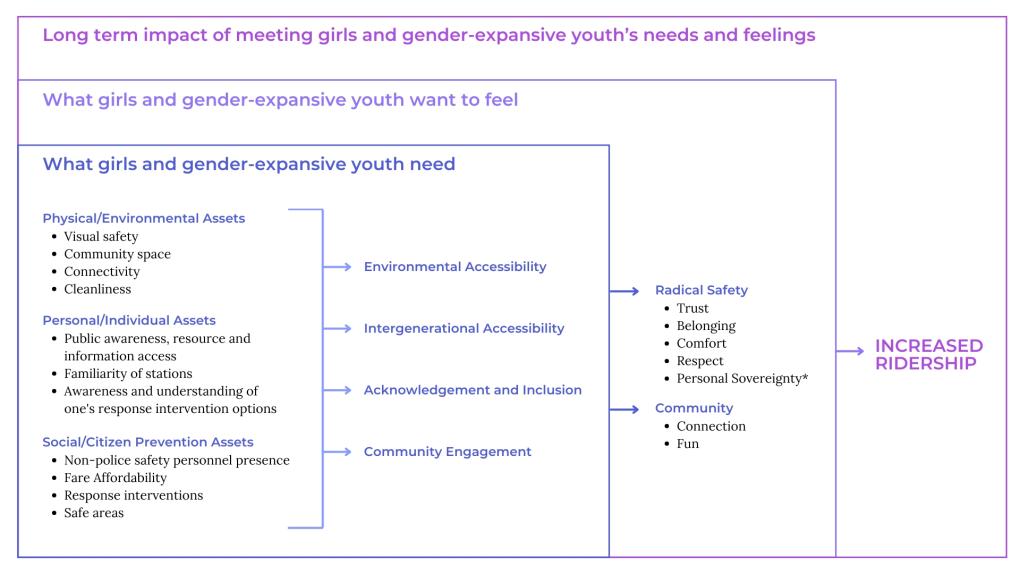
Measuring impact through a potential gender audit
The report presents more than five dozen specific indicators that could make up a gender and safety audit to measure BART’s progress in working towards implementing a fabric of safety that supports the specific needs of girls and gender-expansive youth when riding BART. These include physical and environmental needs such as lighting, cleanliness, and art; personal needs such as access to information and familiarity of stations; and community needs such as fare affordability and activated, multi-use spaces.
Advancing the Not One More Girl oinitiative
BART partnered with Alliance for Girls on this research and outreach process to develop a pathway to root the groundbreaking work of the Not One More Girl initiative to uplift the voices and needs of girls and gender-expansive youth of color and find non-policing solutions to prevent and address sexual harassment and gender-based violence on BART. The work, which has been in partnership with community organizations including Alliance for Girls, the Betti Ono Foundation, The Unity Council, and Black Girls Brilliance, aims to create a culture of care among BART riders and teach safe bystander intervention tips. The effort has led to BART policy changes and system changes based on the feedback from girls and gender-expansive youth.
The Youth-Informed Radical Vision of Safety Evaluation Framework report outlines a recommended approach for BART to continually evaluate if this work is enhancing safety, deepening community engagement, and increasing ridership. The process calls for leveraging data from the recently conducted Mineta Transportation Institute’s Street Harassment on Transit survey; creating instrumentation tools; partnering with community-based organizations to gather further insights from girls and gender-expansive youth; and collaborating on findings to inform a continuous improvement cycle.
Read the full report here. The street harassment survey and the publishing of the report meet the requirements of SB 434, by Senator David Min and signed into law in 2023, requiring the state’s ten largest transit agencies, including BART, to collect comprehensive survey data identifying the leading causes of street harassment on transit and to conduct outreach and gather qualitative data with those who are underrepresented in surveys.
